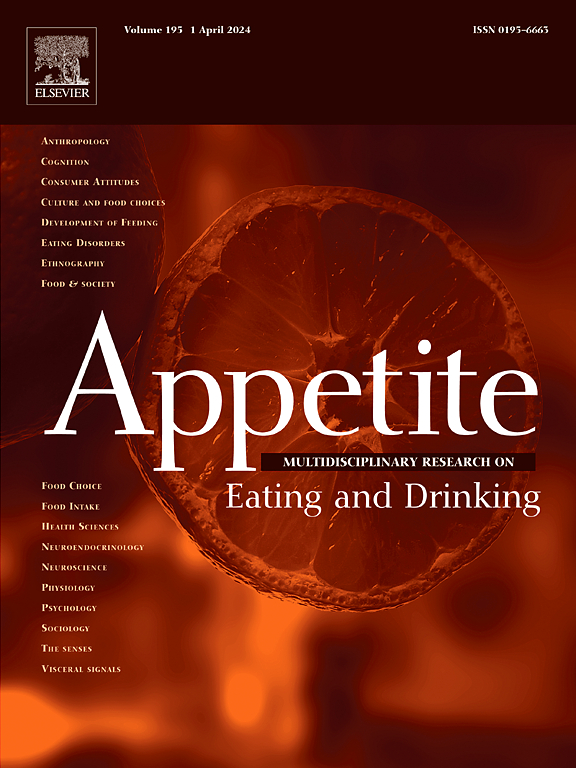食欲减退:食物图像的去饱和减少了渴望,但没有接近偏见。
IF 3.8
2区 医学
Q1 BEHAVIORAL SCIENCES
引用次数: 0
摘要
食物的颜色是一个非常显著的视觉线索,帮助我们评估它的新鲜度和质量。在实验1中,我们研究了食品图像的部分和完全(即灰度)去饱和如何影响易腐和保存食品的显式评价。我们发现,自我报告的渴望和感知的适口性都随着图像饱和度的降低而降低,与保存的食品相比,易腐食品的影响更大。这些结果表明,颜色在食品评估中起着重要作用,尤其是对易腐烂的食品,这可能更多地依赖于新鲜的视觉线索。此外,先前的研究表明,当图像灰度化时,对食物图像的注意偏差被消除了。然而,尚不清楚颜色去饱和度是否也会影响行为/动机反应,如方法偏差。为了解决这个问题,我们进行了实验2和3,使用刺激-反应兼容性任务来评估颜色去饱和度对易腐和保存食品图像接近行为的影响。与之前关于注意偏差的研究结果相反,我们观察到所有食物图像的稳健方法偏差,在饱和条件或食物类型之间没有显着差异。我们的研究结果表明,虽然注意偏差对低级知觉特征(如色彩饱和度)很敏感,但方法偏差可能不太受知觉刺激特性变化的影响。这意味着动机方法反应主要是由与食物奖励的习得关联驱动的,而不是由基本的刺激显著性驱动的,这突出了健康饮食者的注意力和动机过程之间的潜在分离。本文章由计算机程序翻译,如有差异,请以英文原文为准。
Fading appetite: Desaturation of food images reduces cravings but not approach biases
The colour of food serves as a highly salient visual cue, helping us to assess its freshness and quality. In Experiment 1, we investigated how partial and complete (i.e., greyscale) desaturation of food images influenced explicit evaluations of perishable and preserved food items. We found that both self-reported cravings and perceived palatability decreased with decreasing image saturation, with larger effects observed for perishable food items compared to preserved ones. These results suggest that colour plays an important role in food evaluation, especially for perishable items, which may rely more heavily on visual cues of freshness. Furthermore, previous research has shown that attentional biases towards food images are eliminated when the images are grey-scaled. However, it remains unclear whether colour desaturation also affects behavioural/motivational responses, such as approach biases. To address this, we conducted Experiments 2 and 3, using a stimulus-response compatibility task to assess the influence of colour desaturation on approach behaviour towards perishable and preserved food images. Contrary to the previous findings on attentional biases, we observed robust approach biases for all food images, with no significant differences across saturation conditions or food types. Our findings suggest that while attentional biases are sensitive to low-level perceptual features, such as colour saturation, approach biases may be less influenced by variations in perceptual stimulus properties. This implies that motivational approach responses are primarily driven by learned associations with food rewards rather than basic stimulus saliency, highlighting a potential dissociation between attentional and motivational processes in healthy eaters.
求助全文
通过发布文献求助,成功后即可免费获取论文全文。
去求助
来源期刊

Appetite
医学-行为科学
CiteScore
9.10
自引率
11.10%
发文量
566
审稿时长
13.4 weeks
期刊介绍:
Appetite is an international research journal specializing in cultural, social, psychological, sensory and physiological influences on the selection and intake of foods and drinks. It covers normal and disordered eating and drinking and welcomes studies of both human and non-human animal behaviour toward food. Appetite publishes research reports, reviews and commentaries. Thematic special issues appear regularly. From time to time the journal carries abstracts from professional meetings. Submissions to Appetite are expected to be based primarily on observations directly related to the selection and intake of foods and drinks; papers that are primarily focused on topics such as nutrition or obesity will not be considered unless they specifically make a novel scientific contribution to the understanding of appetite in line with the journal's aims and scope.
 求助内容:
求助内容: 应助结果提醒方式:
应助结果提醒方式:


